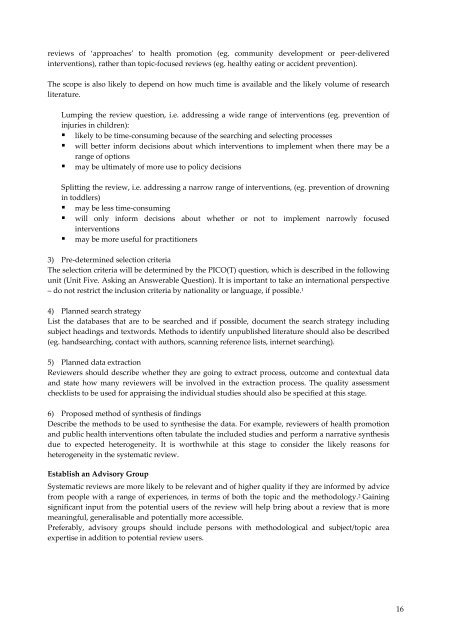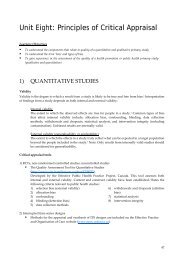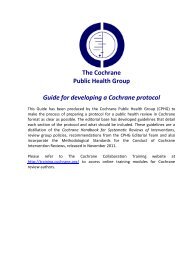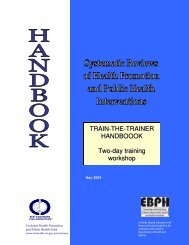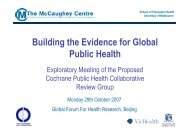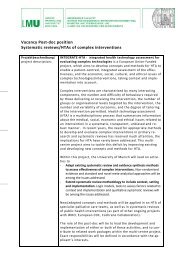Unit Four: Developing a Protocol - Cochrane Public Health Group
Unit Four: Developing a Protocol - Cochrane Public Health Group
Unit Four: Developing a Protocol - Cochrane Public Health Group
You also want an ePaper? Increase the reach of your titles
YUMPU automatically turns print PDFs into web optimized ePapers that Google loves.
eviews of ‘approaches’ to health promotion (eg. community development or peer‐delivered<br />
interventions), rather than topic‐focused reviews (eg. healthy eating or accident prevention).<br />
The scope is also likely to depend on how much time is available and the likely volume of research<br />
literature.<br />
Lumping the review question, i.e. addressing a wide range of interventions (eg. prevention of<br />
injuries in children):<br />
• likely to be time‐consuming because of the searching and selecting processes<br />
• will better inform decisions about which interventions to implement when there may be a<br />
range of options<br />
• may be ultimately of more use to policy decisions<br />
Splitting the review, i.e. addressing a narrow range of interventions, (eg. prevention of drowning<br />
in toddlers)<br />
• may be less time‐consuming<br />
• will only inform decisions about whether or not to implement narrowly focused<br />
interventions<br />
• may be more useful for practitioners<br />
3) Pre‐determined selection criteria<br />
The selection criteria will be determined by the PICO(T) question, which is described in the following<br />
unit (<strong>Unit</strong> Five. Asking an Answerable Question). It is important to take an international perspective<br />
– do not restrict the inclusion criteria by nationality or language, if possible. 1<br />
4) Planned search strategy<br />
List the databases that are to be searched and if possible, document the search strategy including<br />
subject headings and textwords. Methods to identify unpublished literature should also be described<br />
(eg. handsearching, contact with authors, scanning reference lists, internet searching).<br />
5) Planned data extraction<br />
Reviewers should describe whether they are going to extract process, outcome and contextual data<br />
and state how many reviewers will be involved in the extraction process. The quality assessment<br />
checklists to be used for appraising the individual studies should also be specified at this stage.<br />
6) Proposed method of synthesis of findings<br />
Describe the methods to be used to synthesise the data. For example, reviewers of health promotion<br />
and public health interventions often tabulate the included studies and perform a narrative synthesis<br />
due to expected heterogeneity. It is worthwhile at this stage to consider the likely reasons for<br />
heterogeneity in the systematic review.<br />
Establish an Advisory <strong>Group</strong><br />
Systematic reviews are more likely to be relevant and of higher quality if they are informed by advice<br />
from people with a range of experiences, in terms of both the topic and the methodology. 2 Gaining<br />
significant input from the potential users of the review will help bring about a review that is more<br />
meaningful, generalisable and potentially more accessible.<br />
Preferably, advisory groups should include persons with methodological and subject/topic area<br />
expertise in addition to potential review users.<br />
16


